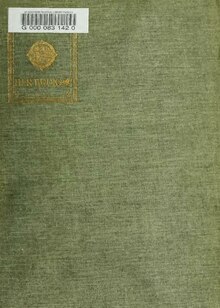
Mary Louisa Boyle (1810 – 1890) was an English writer and amateur actress who moved in the literary circles of Charles Dickens and Alfred, Lord Tennyson.
Early life and writing
She was born on 12 November 1810 at Cavendish Square, London, one of six children of Captain Sir Courtenay Boyle and his wife, Carolina Amelia Poyntz. She was educated at Miss Poggi's school in Brighton. The family lived at Hampton Court until 1840, during which time Mary published her two novels, The State Prisoner (1837) and The Forester: a Tale of 1688 (1839). They then moved to Somerset, where they remained for ten years. Mary produced a book of verse, The Bridal of Melchia, in 1844.
Acting and friendship with Dickens
In the 1840s Mary met the Irish comedic writer Charles Lever while in Florence. He took credit for training her to act in a letter where he referred to her later association with Charles Dickens:
"Mary Boyle—that was Dickens’s prima donna—was of my training; her infant steps (she was five-and-thirty at the time) were first led by me; and I remember holding a ladder for her while she sang a love-song out of a window, and (trying to study my own part at the same time) I set fire to her petticoats!"
In 1849, she met Charles Dickens at Rockingham Castle. She was afterwards a frequent visitor and affectionate correspondent of Dickens, who took her on to act in several of his amateur performances. He later wrote of her "acting in every English shire incessantly, and getting a harvest of laurels all the year round."
In 1851, Dickens heavily edited and published her story, "My Mahogany Friend" (a title of his own suggestion) in his magazine Household Words. He wrote to her about the "thorny track" of professional writing, which has been interpreted as delicately worded advice not to pursue a career as a novelist. Her next work came in 1865, Tangled Weft: Two Stories.
Dickens’ letters to her record several of her gifts to him and call her "among the few whom I most care for and best love." He encouraged her to read Great Expectations in its year of release, writing of its popular appeal. She customarily sent him a flower for his button-hole for his public readings, which she accomplished even when he was in Boston. She was present at Gad's Hill on the day of his death in 1870.
Friendship with Tennyson and later life
Mary became acquainted with Alfred, Lord Tennyson in 1882 when her niece, Audrey, married Tennyson's son Hallam. Tennyson wrote the poem "To Mary Boyle" (publ. 1889) to her, in which he reminisces about their younger days and invites her to keep her promise to leave London and visit him at his country home, Farringford, while she was in a period of bereavement.
She died on 17 April 1890 at her London home. Her memoir was published as Mary Boyle: Her Book by her nephew in 1901.
Works
- The State Prisoner (1837)
- The Forester: a Tale of 1688 (1839)
- The Bridal of Melchia (1844)
- "My Mahogany Friend" (1851)
- Tangled Weft: Two Stories (1865)
- Mary Boyle: Her Book (posthumous, 1901)
References
- ^ Thorn, Michael (2004). "Boyle, Mary Louisa (1810–1890), writer". Oxford Dictionary of National Biography (online ed.). Oxford University Press. doi:10.1093/ref:odnb/61553. Retrieved 2023-12-11. (Subscription or UK public library membership required.)
- Boyle, Mary Louisa (1837). The State prisoner.
- Boyle, Mary Louisa (1839). The forester. Longman, Orme, Brown, Green, & Longmans, Paternoster-Row.
- Boyle, Mary Louisa (1844). The Bridal of Melcha: A Dramatic Sketch. H. Colburn.
- Downey, Edmund (1906). Charles Lever: His Life in His Letters. Vol. II.
- Letter to Mrs Watson, 8 July 1861, The Letters of Charles Dickens vol II (1880), p. 146.
- "Mary Louisa Boyle". www.djo.org.uk. Retrieved 2023-12-11.
- Boyle, Mary Louisa (1865). Tangled Weft: Two Stories. Smith, Elder and Company.
- Letter to Miss Mary Boyle, 27 December 1862, The Letters of Charles Dickens vol II (1880), p. 187.
- Letter to Miss Mary Boyle, 28 December 1860, The Letters of Charles Dickens vol II (1880), p. 134.
- Letter to Miss Mary Boyle, 4 December 1867, The Letters of Charles Dickens vol II (1880), p. 316.
- Tennyson, Alfred, "To Mary Boyle", Demeter and other poems, retrieved 2023-12-11
- Pritchard, William H. (2009). "Epistolary Tennyson: The Art of Suspension". Victorian Poetry. 47 (1): 331–347. ISSN 0042-5206. JSTOR 40347437.
- Rogers, William N. (1981). "Tennyson's Poetry of Social Converse: "To Ulysses"". Victorian Poetry. 19 (4): 351–366. ISSN 0042-5206. JSTOR 40003732.
- Boyle, Mary Louisa (2021-11-05). Mary Boyle, Her Book. Good Press.
- 1810 births
- 1890 deaths
- 19th-century English women writers
- 19th-century English actresses
- 19th-century English novelists
- 19th-century English memoirists
- 19th-century English poets
- 19th-century British letter writers
- Boyle family
- English women novelists
- English women memoirists
- English historical novelists
- Writers of historical fiction set in the early modern period
- Victorian women writers
- Victorian novelists
- Novelists from London
- Charles Dickens
- English women poets
- Victorian poets
- Poets from London
- Actresses from London